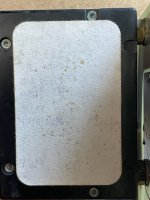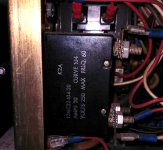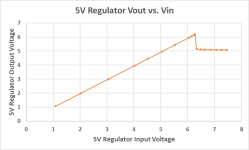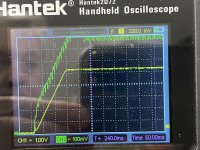gnupublic
Experienced Member
Hello,
I'm beginning to work on my PDP-12 #580, starting with the power supply. I formed the capacitors checked all diodes. Then finally I started it. Most of the voltages came up, just missing 10V. The 50W 10V zenerdiode was defect.
I replaced this with a "super zener" build from an TL431 driving an Darlington transistor. I managed this to fit it using the plugs at the cooler. So it can be replaced easy if I can get this original zenerdiode.
5V was exact 5.06V and I tried to put some load on it. When switchen the power supply on and off sometimes the crowbar rises. Awfully this does not bring the circuit braker to open (without further load), so the 0.1 Ohm resistor got very hot and burned the board a little bit.
Later, with some load of 50 or 100W the circuit breaker opend, if the crowbar rises.
I read some similar problems of power supplys from 8/L and I will try to find out what I can do to avoid a voltage peak when switching on.
When I switched on with 150W of load, one time the crowbar rises and now the transistors are faulty. Both 2N4398 are defect.
I did not expext to be able to kill them, because of the circuit breaker, expected this to limit the current. The 2n4398 can do 200W or 30A (50A peak). So I expected to be able to drive more than 30A with both transistors.
But I cannot find any current values in the documents, can anybody point me to? The power supply named 724 maybe similar to the H724 of the 8/e. There I find 5V @20A (100W). Is this plausible for a PDP-12 also?
I'm beginning to work on my PDP-12 #580, starting with the power supply. I formed the capacitors checked all diodes. Then finally I started it. Most of the voltages came up, just missing 10V. The 50W 10V zenerdiode was defect.
I replaced this with a "super zener" build from an TL431 driving an Darlington transistor. I managed this to fit it using the plugs at the cooler. So it can be replaced easy if I can get this original zenerdiode.
5V was exact 5.06V and I tried to put some load on it. When switchen the power supply on and off sometimes the crowbar rises. Awfully this does not bring the circuit braker to open (without further load), so the 0.1 Ohm resistor got very hot and burned the board a little bit.
Later, with some load of 50 or 100W the circuit breaker opend, if the crowbar rises.
I read some similar problems of power supplys from 8/L and I will try to find out what I can do to avoid a voltage peak when switching on.
When I switched on with 150W of load, one time the crowbar rises and now the transistors are faulty. Both 2N4398 are defect.
I did not expext to be able to kill them, because of the circuit breaker, expected this to limit the current. The 2n4398 can do 200W or 30A (50A peak). So I expected to be able to drive more than 30A with both transistors.
But I cannot find any current values in the documents, can anybody point me to? The power supply named 724 maybe similar to the H724 of the 8/e. There I find 5V @20A (100W). Is this plausible for a PDP-12 also?




